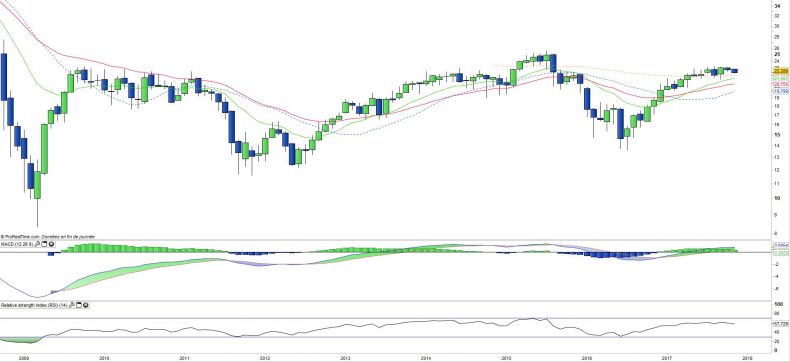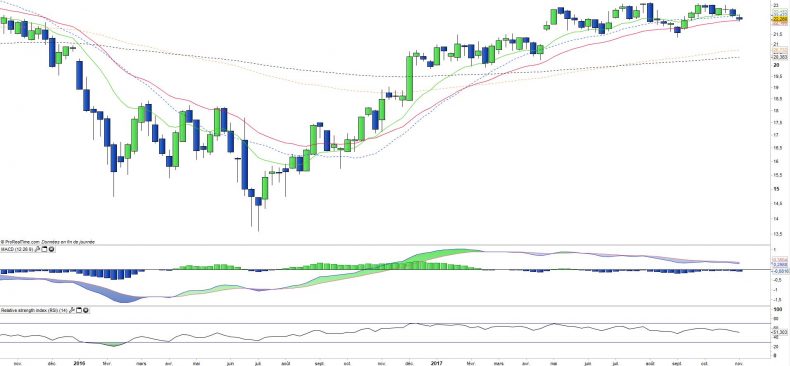Lyxor ETF Stoxx600 Bank (BNK) - 10/11/2017
Short Term strategy : Neutral (50%) / Trend -
Long Term strategy : Positive (95%) / Trend =
Characteristics of the ETF
ETF Lyxor BNK (Banks Europe) created in 08/2006 is listed in Euro on Euronext and seeks to replicate the STOXX600 Bank Europe Index which is composed of the main European banking stocks. About half of the capitalization quotes in Euro, the other half is made up of English, Swiss and Nordic banks.
The costs of this ETF are 0.3% and the AUM is approximately € 815M. Replication is indirect (via a swap) and there is a dividend capitalization policy. BNK is eligible for PEA.
Alternative ETFs: CB5 (Amundi in Euro), EXV1 (iShares in Euro), SYB (BNPP Easy in Euro)
Index & components
The interest of the BNK tracker lies in the fact that it brings together the 46 largest banks in the main European economies, with a great geographical diversity and a good north / south mix (of which 27% UK, 16% Spain, 12% France, 9% Italy, 9% Switzerland) while relying on the strongest and most capitalized stocks. BNK brings together banks specialized in retail (Lloyds or Santander for example) but also so-called universal banks such as French (BNP, SG and CA) which rely on both an investment banking model and retail. The activities of the big banks are well represented.
Banks are currently in "transition", while the crisis of 2008 has left impacts on several levels. As a result of central bank actions and QE programs, banks experienced margins erosion because of negative rates while they can no longer pay deposits by placing them at the ECB. On the other hand, the increased regulatory requirements have forced banks to significantly increase their own funds, which amounts to reducing the leverage and therefore the risks associated with their operations, but mechanically leads to lower ROCEs.
In addition, the banking model is increasingly challenged by more innovative players, the "fintechs" who redefine the customer relationship and the notion of service in the financial world through offers with high technological content, while new approaches disruptive devices such as the blockchain that secures transactions outside any "third party" could in the long run threaten the role of banks as go between in the economies of developed countries. However, bank valuations already incorporate many of these risks, while a number of them have already embarked on ambitious transformation / digitization plans and should take advantage of ongoing changes. In the same way that the distribution was reshaped 20 years ago by the arrival of the web actors, without disappearing so far, it is likely that banks will follow the same path of adaptation and modernization including the buying of fintechs.
Significant bullish catalysts have emerged in recent months, with banking restructuring in Italy bringing more visibility to the sector, and rising US banks in anticipation of accelerated deregulation by the new US administration. The European policy cycle has turned out favorably, first in the Netherlands and then in France, which reinforces the integrity of the euro zone, which is crucial for banks and should be a positive factor for European growth in the short and medium term. The best outlook for the eurozone should result in reflation and therefore a gradual normalization of the European Central Bank's policy.
Latest developments
BNK posted a negative performance of -4.1% in 2016, lower than the Stoxx600NR and gained 12.1% since the beginning of the year, in line with the Stoxx600NR. The index has been flat since its peak in June and did not benefit from the general market rally that took place in September.
This is due in the first place to the very accommodating statement of the ECB, which will certainly decrease very gradually its unconventional support to the economy (QE will go from € 60bn to € 30bn of redemptions per month from March to September 2018), but that does not exclude reaccelerating its program in the event of low inflation, which for the moment is almost non-existent. Long-term rates are therefore at a new low with German 10-year yields rebounding to 0.33%, so rate re-identification and improved bank margins are not on the agenda. A second factor plays negatively, it is the results of the T3 that show poor trading results due to the low volatility of the summer. In particular, French banks have disappointed investors this quarter.
Monthly data
The monthly chart shows a positive past trend in early 2017, after a very significant correction at the end of 2016 (high-yield crisis).
The current configuration is not very reassuring, as prices are forming a round top which, if confirmed, could potentially lead to a large correction or a change in trend. The round top pattern can also be seen on the oscillators and in particular on the MACD. This kind of structure takes time to build up, and for the moment it is only a rough outline but it deserves to be monitored.
Weekly data
On the weekly chart, we can also observe the formation of the rounded summit which is materialized by a flattening of the moving averages 13E and 26E.
The MACD moves towards the zero line which in case of bearish crossing would give an additional warning. For the moment, the price structure is rather flat, which needs to be monitored, but it does not appear to have a high risk of dropping out in the short term.
ETF Objective
BNK is a UCITS compliant ETF that aims to replcate the benchmark index Stoxx Europe 600 Banks Net Return (46 banks)
Characteristics
| Inception date | 25/08/2006 |
| Expense ratio | 0,30% |
| Issuer | Lyxor |
| Benchmark | Stoxx600 Banque |
| Ticker | BNK |
| ISIN | FR0010345371 |
| UCITS | Yes |
| EU-SD status | Out of Scope |
| Currency | € |
| Exchange | Euronext Paris |
| Assets Under Management | 815 M€ |
| Dividend | Capitalization |
| PEA (France) | Yes |
| SRD (France) | Yes |
| Currency Risk | Yes |
| Number of Holdings | 46 |
| Risk | 4/5 |
Country Breakdown
| United Kingdom | 27% |
| Spain | 16% |
| France | 12% |
| Switzerland | 9% |
| Italy | 9% |
| Sweden | 8% |
| Netherlands | 7% |
| Germany | 4% |
| Others | 6% |
Sector Breakdown
| Financials | 100% |
Top Ten Holdings
| HSBC Holdings | 16% |
| Banco Santander | 8% |
| BNP Paribas | 7% |
| ING Group | 6% |
| UBS Group | 5% |
| Lloyds Banking Group | 5% |
| BBVA | 4% |
| Intesa San Paolo | 4% |
| Société Générale | 3% |
| Unicredit | 3% |


